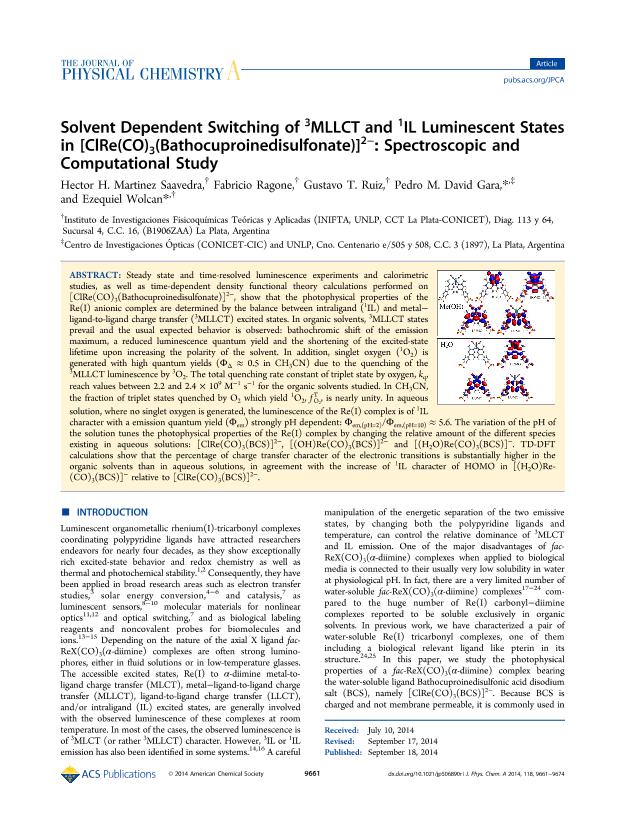Artículo
Solvent dependent switching of 3MLLCT and 1IL luminescent states in [ClRe(CO)3(Bathocuproinedisulfonate)]2-: Spectroscopic and computational study
Martínez Saavedra, Héctor Hernando ; Ragone, Fabricio; Ruiz, Gustavo Teodosio
; Ragone, Fabricio; Ruiz, Gustavo Teodosio ; David Gara, Pedro Maximiliano; Wolcan, Ezequiel
; David Gara, Pedro Maximiliano; Wolcan, Ezequiel
 ; Ragone, Fabricio; Ruiz, Gustavo Teodosio
; Ragone, Fabricio; Ruiz, Gustavo Teodosio ; David Gara, Pedro Maximiliano; Wolcan, Ezequiel
; David Gara, Pedro Maximiliano; Wolcan, Ezequiel
Fecha de publicación:
09/2014
Editorial:
American Chemical Society
Revista:
Journal Of Physical Chemistry A
ISSN:
1089-5639
Idioma:
Inglés
Tipo de recurso:
Artículo publicado
Clasificación temática:
Resumen
Steady state and time-resolved luminescence experiments and calorimetric studies, as well as time-dependent density functional theory calculations performed on [ClRe(CO)3(Bathocuproinedisulfonate)]2−, show that the photophysical properties of the Re(I) anionic complex are determined by the balance between intraligand (1IL) and metal−ligand-to-ligand charge transfer (3MLLCT) excited states. In organic solvents, 3MLLCT states prevail and the usual expected behavior is observed: bathochromic shift of the emission maximum, a reduced luminescence quantum yield and the shortening of the excited-state lifetime upon increasing the polarity of the solvent. In addition, singlet oxygen (1O2) is generated with high quantum yields (ΦΔ ≈ 0.5 in CH3CN) due to the quenching of the 3MLLCT luminescence by 3O2. The total quenching rate constant of triplet state by oxygen, kq,reach values between 2.2 and 2.4 × 109 M−1 s−1 for the organic solvents studied. In CH3CN, the fraction of triplet states quenched by O2 which yield 1O2, f O2T , is nearly unity. In aqueous solution, where no singlet oxygen is generated, the luminescence of the Re(I) complex is of 1IL character with a emission quantum yield (Φem) strongly pH dependent: Φem,(pH=2)/Φem,(pH=10) ≈ 5.6. The variation of the pH of the solution tunes the photophysical properties of the Re(I) complex by changing the relative amount of the different species existing in aqueous solutions:[ClRe(CO)3(BCS)]2−, [(OH)Re(CO)3(BCS)]2− and [(H2O)Re(CO)3(BCS)]−. TD-DFT calculations show that the percentage of charge transfer character of the electronic transitions is substantially higher in the organic solvents than in aqueous solutions, in agreement with the increase of 1IL character of HOMO in [(H2O)Re(CO)3(BCS)]− relative to [ClRe(CO)3(BCS)]2−.
Palabras clave:
Baocuproina
,
Complejos
,
Organometalicos
,
Fotoquimica
Archivos asociados
Licencia
Identificadores
Colecciones
Articulos(CCT - LA PLATA)
Articulos de CTRO.CIENTIFICO TECNOL.CONICET - LA PLATA
Articulos de CTRO.CIENTIFICO TECNOL.CONICET - LA PLATA
Articulos(INIFTA)
Articulos de INST.DE INV.FISICOQUIMICAS TEORICAS Y APLIC.
Articulos de INST.DE INV.FISICOQUIMICAS TEORICAS Y APLIC.
Citación
Martínez Saavedra, Héctor Hernando; Ragone, Fabricio; Ruiz, Gustavo Teodosio; David Gara, Pedro Maximiliano; Wolcan, Ezequiel; Solvent dependent switching of 3MLLCT and 1IL luminescent states in [ClRe(CO)3(Bathocuproinedisulfonate)]2-: Spectroscopic and computational study; American Chemical Society; Journal Of Physical Chemistry A; 118; 9-2014; 9661-9674
Compartir
Altmétricas



